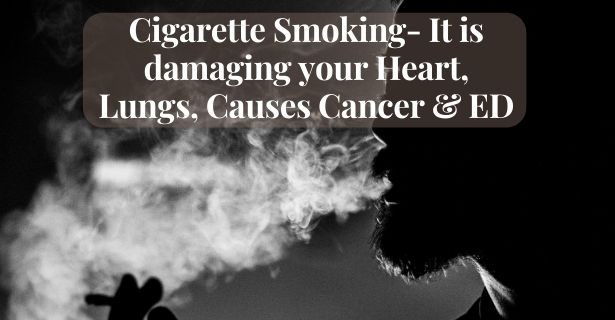
Cigarette Smoking- It’s affects over Heart, Lungs, Causes Cancer, ED
Cigarette Smoking:- Drug abuse is a serious problem not only in India but also worldwide. Moreover, abusing alcohol and drugs at the same time increases the risk of adverse outcomes because an abused drug can be toxic at a lower blood level in the presence of alcohol.
Many habits can significantly increase oxidative stress in the human body, including smoking, alcohol and drug abuse. It has been well-publicized that cigarette smoking is a health hazard.
Today we Discuss Cigarette Smoking and its Health Hazards including the following aspects
- Composition of Cigarette Smoke
- Nicotine: The Main Cause of Addiction
- Cigarette Smoking and Oxidative Stress
- Health hazards of smoking
- Cigarette Smoking is Related to Many Diseases
How cigarette smoking affects the Heart, Lungs, Causes Cancer, side effects on Female Reproduction, causes erectile dysfunction, affects to Eyes health.
Compositions of Cigarette Smoke
More than 4800 compounds have been identified in cigarette smoke. Approximately 400500 compounds are present in the gaseous phase, and approximately 300 of these compounds are classified as semivolatile compounds.
The composition of cigarette smoke is complex, comprising gaseous components that contain carbon monoxide, nitrogen oxide, and hydrogen cyanide as well as many volatile organic compounds and particulate matter that consists of submicrometer-sized particles. Various compounds may be associated with particulate matter, such as nicotine, tobacco-specific nitrosamines, and polyaromatic hydrocarbons.
Particulate matter may also be loosely defined as cigarette tar material. Although the major danger of cigarette smoking is associated with smokers who inhale mostly mainstream smoke, nonsmokers who are in close proximity to smokers are also exposed to sidestream smoke that is emitted in the surrounding air between puffs from the ends of smouldering cigarettes.
Sidestream smoke is diluted compared to mainstream smoke and has a composition different from it, but inhaling sidestream smoke is also unhealthy
TOXIC CHEMICALS PRESENT IN CIGARETTE SMOKE
| Major components | Tar, nicotine, carbon monoxide |
| Inorganic gas | Ammonia, hydrogen cyanide, nitrous and nitric oxide |
| Metals | Lead, chromium, mercury, arsenic, cadmium, selenium |
| Tobacco-specific nitrosamine | N’0-nitrosonornicotine, N0-nitrosoanabasine, N0-nitrosoanatabine, 4-(methylnitroso)-1-(-3-pyridyl)-1butanone |
| Phenols | Phenol, o-cresol, m-cresol, p-cresol, catechol, resorcinol, hydroquinone |
| Carbonyls – | Formaldehyde, acetaldehyde, acetone, propionaldehyde, methyl ethyl, ketone, acrolein, butyraldehyde, crotonaldehyde |
| Aromatic amines | 1-Aminonaphthalene, 2aminonaphthalene, 3aminobiphenyl, 4-aminobiphenyl |
| Other organic compounds | Benzene, toluene, 1,3-butadiene, isoprene, acrylonitrile, pyridine |
Nicotine: The Main Cause of Addiction
Why Nicotine is so Addictive?
The main cause of this addiction is nicotine. Nicotine fulfils all criteria for an abused drug that produces drug dependence due to both its psychoactive effect.
Physiological dependence on nicotine is due to its action on nicotinic acetylcholine receptors in the human brain. When nicotine activates such receptors, neurotransmitters such as dopamine (major component), norepinephrine, acetylcholine, and β-endorphin are released, which produces pleasurable experiences and a reduction of anxiety and stress.
With repeated smoking, these receptors are increased in number and may also become desensitized. Although nicotine is mainly responsible for addiction, components such as acetaldehyde may enhance the physiological properties of nicotine
Cigarette Smoking and Oxidative Stress
Oxidative stress is responsible for the association between various diseases and smoking. In addition, smoking may also induce other conditions, such as dyslipidemia, glucose intolerance, and nutritional abnormalities Cigarette smoke contains many free radicals and other oxidizing compounds that may induce free radical production upon entering the lungs and circulation.
The vapor phase of cigarette smoke may contain up to 1015 free radicals per puff of a cigarette, and these reactive substances can enter the bloodstream, inducing direct oxidative stress in the circulation. However, both vapor phase and particulate matter of cigarette smoke contain free radicals, including reactive oxygen species, reactive nitrogen species, superoxide, hydroxyl radicals, nitric oxide, and hydrogen peroxide.
Although these free radicals and oxidants present in the vapor phase of cigarette smoke have a short half-life, they can enter the bloodstream, causing oxidative damage to macromolecules. The vapor phase of cigarette smoke also contains saturated and unsaturated aldehydes, which are more stable than free radicals and hydrogen peroxide.
These compounds can also enter the bloodstream, generating reactive oxygen species, especially through interacting with enzymes such as nicotinamide adenine dinucleotide phosphate oxidase (NADPH). As a result, tissues distant from the lungs can also experience increased oxidative stress
Health hazards of smoking
The major health hazards of smoking are various pulmonary diseases including lung cancer and noncancerous lung diseases, and atherosclerotic diseases of the heart and blood vessels, as well as various cancers and toxicity to the human reproductive system.
It has been well documented that a large number of free radicals and oxidants present in inhaled cigarette smoke induces adverse effects on tissues and organs through oxidative damage of key biological molecules.
In addition, cigarette smoke can induce activation of inflammatory cells, thus further contributing to additional oxidative stress. Products of lipid peroxidation, protein and thiol oxidation, and oxidized DNA are increased in smokers compare to nonsmokers, further indicating increased oxidative stress in smokers.
Cigarette Smoking is Related to Many Diseases-
How cigarette smoking affects the Heart?
Many studies have shown an association between cigarette smoking and an increased risk of cardiovascular diseases. Exposure to cigarette smoke induces multiple pathological effects in the endothelium, and many of these effects are related to increased oxidative stress induced by reactive oxygen species, reactive nitrogen species, and other oxidants present in cigarette smoke.
In addition, reactive oxygen species can upregulate inflammatory cytokines and may cause endothelium dysfunction by reducing the bioavailability of nitric oxide. Increased plaque formation and the development of vulnerable plaques also result from exposure to cigarette smoke due to the inflammatory process and activation of matrix metalloproteins.
Moreover, cigarette smoke can cause platelet activation and stimulation of the coagulation cascade, thus increasing the risk of atherothrombotic disease
How Cigarette smoking affects the Lungs?
Chronic obstructive pulmonary disease (COPD) is strongly associated with cigarette smoking. COPD has a considerable impact on exercise tolerance and quality of life as well as increased mortality in these individuals. Oxidative stress induced by cigarette smoke is considered a major factor contributing to muscle dysfunction and muscle wasting in COPD.
Smoking one cigarette exposes the human respiratory tract to 15,00040,000 μg particulate matter
The oxidative damage to muscle proteins usually precedes the characteristic respiratory changes in COPD patients. Cigarette smoke also causes direct oxidative stress and proinflammatory responses of cells in the lungs. Sangani and Ghio proposed that lung injury after cigarette smoking is related to particulate matter. Smoking one cigarette exposes the human respiratory tract to 15,00040,000 μg particulate matter, and exposure to these particles produces oxidative stress, the initial step in smoking-induced lung injury.
Cigarette smoking and Cancer
Smoking increases the risk of cancer in various organs. It contains many carcinogens, including benzene(a)pyrene, dibenzoacridine, various nitrosamines, aromatic amines, and aldehydes including formaldehyde as well as benzene and other aromatic hydrocarbons. In addition, free radicals associated with cigarette smoke can be involved in chemical carcinogenesis. Cigarette tar radicals can also cause significant DNA damage.
Cigarette smoking & erectile dysfunction
Cigarette smoking may cause erectile dysfunction with the impaired arterial flow to the penis or acute vasospasm of the penile arteries. Smoking probably affects penile erection through the impairment of endothelium-dependent smooth muscle relaxation by affecting nitric oxide production via increased generation of reactive oxygen species.
Cigarette smoking Side effects on Female Reproduction
Cigarette smoking has an adverse dose-dependent effect on ovarian function. The increased miscarriage rate among mothers who smoke may be related to the direct adverse effects of nicotine, cadmium, and polyaromatic hydrocarbons on trophoblast invasion and proliferation. Dittrich et al. reported that the concentration of malondialdehyde was higher in the amniotic fluid of mothers who smoked compared to that of nonsmoker mothers.
Cigarette smoking Side effects on Eyes health
Age-related macular degeneration is a leading cause of blindness among the elderly, and cigarette smoking is the strongest epidemiological risk factor for developing macular degeneration. Smoking-related oxidative damage during the early phase of macular degeneration has been documented. Moreover, oxidative stress to the retinal pigmented epithelium may also contribute to the pathogenesis of macular degeneration.
Various Diseases Associated with Smoking Disease
| Disease Type | Specific Diseases/Location/Effect |
| Pulmonary disease | Bronchitis, pneumonia, emphysema, chronic obstructive pulmonary disease |
| Cardiovascular disease | Ischemic heart disease, atherosclerosis, aortic aneurysm |
| Cerebrovascular disease | Various strokes |
| Skeletal muscle dysfunction | Muscle loss and dysfunction reduced adipose tissue |
| Cancer | Lips, oral cavity, pharynx, esophagus, stomach, lung, kidney, cervix, uterus, prostate, colon, acute myeloid leukaemia |
| Reproductive system | Impaired female fertility, impotence in males, poor pregnancy outcome, earlier menopause |
| Eye diseases | Cataract, macular degeneration |
| Other problems | glucose intolerance, anorexia, weight loss |
Reference -Antioxidants in Food, Vitamins and Supplements Prevention and Treatment of Disease by Amitava Dasgupta and Kimberly Klein
Read Also:-6 Ways You Can Convert Water Into Super Water For Healing



 English
English French
French
